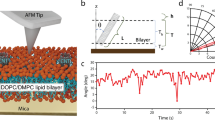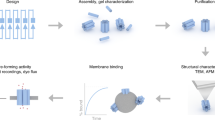Abstract
Carbon nanotube porins (CNTPs) are 10- to 20-nm-long segments of lipid-stabilized single-walled carbon nanotubes (CNTs) that can be inserted into phospholipid membranes to form nanometer-scale-diameter pores that approximate the geometry and many key transport characteristics of biological membrane channels. We describe protocols for CNTP synthesis by ultrasound-assisted cutting of long CNTs in the presence of lipid amphiphiles, and for validation of CNTP incorporation into a lipid membrane using a proton permeability assay. In addition, we describe protocols for measuring conductance of individual CNTPs in planar lipid bilayers and plasma membranes of live cells. The protocol for the preparation and testing of the CNTPs in vesicle systems takes 3 d, and single CNTP conductance measurements take 2–5 h. The CNTPs produced by this cutting protocol remain stable and active for at least 10–12 weeks.
This is a preview of subscription content, access via your institution
Access options
Subscribe to this journal
Receive 12 print issues and online access
$259.00 per year
only $21.58 per issue
Buy this article
- Purchase on Springer Link
- Instant access to full article PDF
Prices may be subject to local taxes which are calculated during checkout






Similar content being viewed by others
References
Noy, A. et al. Nanofluidics in carbon nanotubes. Nano Today 2, 22–29 (2007).
Aidley, D.J. & Stanfield, P.R. Ion Channels: Molecules in Action (Cambridge University Press, 1996).
Fyles, T. Synthetic ion channels in bilayer membranes. Chem. Soc. Rev. 36, 335–347 (2007).
Hummer, G., Rasaiah, J.C. & Noworyta, J.P. Water conduction through the hydrophobic channel of a carbon nanotube. Nature 414, 188–190 (2001).
Daiguji, H., Yang, P. & Majumdar, A. Ion transport in nanofluidic channels. Nano Lett. 4, 137–142 (2004).
Dellago, C., Naor, M.M. & Hummer, G. Proton transport through water-filled carbon nanotubes. Phys. Rev. Lett. 90, 105902 (2003).
Holt, J.K. et al. Fast mass transport through sub-2-nanometer carbon nanotubes. Science 312, 1034–1037 (2006).
Dekker, C. Solid-state nanopores. Nat. Nanotechnol. 2, 209–215 (2007).
Shen, Y.-x., Saboe, P.O., Sines, I.T., Erbakan, M. & Kumar, M. Biomimetic membranes: a review. J. Membr. Sci. 454, 359–381 (2014).
Agre, P., Bonhivers, M. & Borgnia, M.J. The aquaporins, blueprints for cellular plumbing systems. J. Biol. Chem. 273, 14659–14662 (1998).
Kozono, D., Yasui, M., King, L.S. & Agre, P. Aquaporin water channels: atomic structure molecular dynamics meet clinical medicine. J. Clin. Invest. 109, 1395–1399 (2002).
Doyle, D.A. et al. The structure of the potassium channel: molecular basis of K+ conduction and selectivity. Science 280, 69–77 (1998).
Savage, D.F., Egea, P.F., Robles-Colmenares, Y., O'Connell III, J.D. & Stroud, R.M. Architecture and selectivity in aquaporins: 2.5 Å X-ray structure of aquaporin Z. PLoS Biol. 1, e72 (2003).
Gu, L.Q., Braha, O., Conlan, S., Cheley, S. & Bayley, H. Stochastic sensing of organic analytes by a pore-forming protein containing a molecular adapter. Nature 398, 686–690 (1999).
Sone, Y., Ekdunge, P. & Simonsson, D. Proton conductivity of Nafion 117 as measured by a four-electrode AC impedance method. J. Electrochem. Soc. 143, 1254–1259 (1996).
Randa, H.S., Forrest, L.R., Voth, G.A. & Sansom, M.S. Molecular dynamics of synthetic leucine-serine ion channels in a phospholipid membrane. Biophys. J. 77, 2400–2410 (1999).
Le Duc, Y. et al. Imidazole-quartet water and proton dipolar channels. Angew. Chem. Int. Ed. 50, 11366–11372 (2011).
Majumder, M., Chopra, N., Andrews, R. & Hinds, B.J. Nanoscale hydrodynamics: enhanced flow in carbon nanotubes. Nature 438, 44–44 (2005).
Geng, J. et al. Stochastic transport through carbon nanotubes in lipid bilayers and live cell membranes. Nature 514, 612–615 (2014).
Sun, L. & Crooks, R.M. Single carbon nanotube membranes: a well-defined model for studying mass transport through nanoporous materials. J. Am. Chem. Soc. 122, 12340–12345 (2000).
Hinds, B.J. et al. Aligned multiwalled carbon nanotube membranes. Science 303, 62–65 (2004).
Lee, C.Y., Choi, W., Han, J.-H. & Strano, M.S. Coherence resonance in a single-walled carbon nanotube ion channel. Science 329, 1320–1324 (2010).
Liu, H. et al. Translocation of single-stranded DNA through single-walled carbon nanotubes. Science 327, 64–67 (2010).
Liu, L., Yang, C., Zhao, K., Li, J. & Wu, H.-C. Ultrashort single-walled carbon nanotubes in a lipid bilayer as a new nanopore sensor. Nat. Commun. 4, 2989 (2013).
Misra, N. et al. Bioelectronic silicon nanowire devices utilizing functional membrane proteins. Proc. Natl. Acad. Sci. USA 106, 13780–13784 (2009).
Tunuguntla, R.H. et al. Bioelectronic light-gated transistors with biologically tunable performance. Adv. Mater. 27, 831–836 (2015).
Zhong, C. et al. A polysaccharide bioprotonic field-effect transistor. Nat. Commun. 2, 476 (2011).
Sun, X. et al. Optical properties of ultrashort semiconducting single-walled carbon nanotube capsules down to sub-10 nm. J. Am. Chem. Soc. 130, 6551–6555 (2008).
Hirano-Iwata, A., Ishinari, Y., Yamamoto, H. & Niwano, M. Micro-and nano-technologies for lipid bilayer-based ion-channel functional assays. Chem. Asian J. 10, 1266–1274 (2015).
Zagnoni, M. Miniaturised technologies for the development of artificial lipid bilayer systems. Lab Chip 12, 1026–1039 (2012).
Gutsmann, T., Heimburg, T., Keyser, U., Mahendran, K.R. & Winterhalter, M. Protein reconstitution into freestanding planar lipid membranes for electrophysiological characterization. Nat. Protoc. 10, 188–198 (2015).
Frolov, V.A., Lizunov, V.A., Dunina-Barkovskaya, A.Y., Samsonov, A.V. & Zimmerberg, J. Shape bistability of a membrane neck: a toggle switch to control vesicle content release. Proc. Natl. Acad. Sci. USA 100, 8698–8703 (2003).
Linley, J.E. Perforated whole-cell patch-clamp recording. Methods Mol. Biol. 998, 149–157 (2013).
Dresselhaus, M.S. & Saito, R. Physical Properties of Carbon Nanotubes (Imperial College Press, 1998).
Dellago, C. & Hummer, G. Kinetics and mechanism of proton transport across membrane nanopores. Phys. Rev. Lett. 97, 245901 (2006).
Hummer, G. Water, proton, and ion transport: from nanotubes to proteins. Mol. Phys. 105, 201–207 (2007).
Flavel, B.S., Moore, K.E., Pfohl, M., Kappes, M.M. & Hennrich, F. Separation of single-walled carbon nanotubes with a gel permeation chromatography system. ACS Nano 8, 1817–1826 (2014).
Arnold, M.S., Green, A.A., Hulvat, J.F., Stupp, S.I. & Hersam, M.C. Sorting carbon nanotubes by electronic structure using density differentiation. Nat. Nanotech. 1, 60–65 (2006).
Arnold, M.S., Stupp, S.I. & Hersam, M.C. Enrichment of single-walled carbon nanotubes by diameter in density gradients. Nano Lett. 5, 713–718 (2005).
Moshammer, K., Hennrich, F. & Kappes, M.M. Selective suspension in aqueous sodium dodecyl sulfate according to electronic structure type allows simple separation of metallic from semiconducting single-walled carbon nanotubes. Nano Res. 2, 599–606 (2009).
Antonov, V., Petrov, V., Molnar, A., Predvoditelev, D. & Ivanov, A. The appearance of single-ion channels in unmodified lipid bilayer membranes at the phase transition temperature. Nature 283, 585–586 (1980).
Neher, E. & Sakmann, B. Single-channel Recording (Plenum Press, 1995).
Mueller, P., Rudin, D.O., Ti Tien, H. & Wescott, W.C. Reconstitution of cell membrane structure in vitro and its transformation into an excitable system. Nature 194, 979–980 (1962).
Melikov, K.C., Samsonov, A.V., Pirutin, S.K. & Frolov, V.A. Study of conductance changes of bilayer lipid membrane induced by electric field. Membr. Cell Biol. 13, 121–130 (1999).
Tunuguntla, R.H., Allen, F.I., Kim, K., Belliveau, A. & Noy, A. Ultrafast proton transport in sub-1-nm diameter carbon nanotube porins. Nat. Nanotechnol. 11, 639–644 (2016).
Desai, S.A., Bezrukov, S.M. & Zimmerberg, J.A Voltage-dependent channel involved in nutrient uptake by red blood cells infected with the malaria parasite. Nature 406, 1001–1005 (2000).
Mortensen, M. & Smart, T.G. Single-channel recording of ligand-gated ion channels. Nat. Protoc. 2, 2826–2841 (2007).
Acknowledgements
We thank K. Kim, J. Zhang, and J. Geng for developing some of the initial CNTP synthesis and testing protocols; L. Comolli, F.I. Allen, and Y. Wang for acquiring the cryo-TEM and HR-TEM images of CNTPs; and A.V. Shnyrova for assistance in the development of CNTP-in-BLM protocols and critical reading of the manuscript. Parts of this work were supported by the US Department of Energy, Office of Basic Energy Sciences, Division of Materials Sciences and Engineering (characterization and transport studies), and the LDRD program at LLNL, 12-ERD-073 (synthesis). Work at LLNL was performed under the auspices of the US Department of Energy under contract DE-AC52-07NA27344. Work at the Molecular Foundry was supported by the Office of Science, Office of Basic Energy Sciences, of the US Department of Energy under contract DE-AC02-05CH11231. Work at the Biofisika Institute (CSIC, UPV/EHU) was supported by the Spanish Ministry of Economy and Competitiveness (grant BIO2013-49843-EXP).
Author information
Authors and Affiliations
Contributions
R.H.T. and A.N. developed the protocol for optimized CNTP preparation procedure and assays for CNTP characterization. A.E. and V.A.F. developed the protocols for optimized single-CNTP conductance measurement assays and CNTP incorporation into live cells. All authors contributed to data analysis, discussion, and manuscript preparation.
Corresponding author
Ethics declarations
Competing interests
The authors declare no competing financial interests.
Rights and permissions
About this article
Cite this article
Tunuguntla, R., Escalada, A., A Frolov, V. et al. Synthesis, lipid membrane incorporation, and ion permeability testing of carbon nanotube porins. Nat Protoc 11, 2029–2047 (2016). https://doi.org/10.1038/nprot.2016.119
Published:
Issue Date:
DOI: https://doi.org/10.1038/nprot.2016.119
This article is cited by
-
Breakdown of the Nernst–Einstein relation in carbon nanotube porins
Nature Nanotechnology (2023)
-
Bioinspired and biomimetic membranes for water purification and chemical separation: A review
Frontiers of Environmental Science & Engineering (2021)
-
Reconstitution and real-time quantification of membrane remodeling by single proteins and protein complexes
Nature Protocols (2020)
-
Carbon nanotube porin diffusion in mixed composition supported lipid bilayers
Scientific Reports (2020)
-
Combining patch-clamping and fluorescence microscopy for quantitative reconstitution of cellular membrane processes with Giant Suspended Bilayers
Scientific Reports (2019)
Comments
By submitting a comment you agree to abide by our Terms and Community Guidelines. If you find something abusive or that does not comply with our terms or guidelines please flag it as inappropriate.



